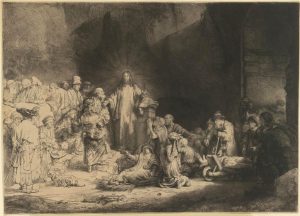
11 etchings (1628-54)
Various sizes
Purchased, 1891 (advice of Hubert von Herkomer)
National Gallery of Victoria (p.185.4-1 to 9.1 & p.186.1-1 to 5-1)
[photo: “The Hundred Guilder Print” (p.186.1-1)]
The individual prints acquired in 1891 are as follows:
Rembrandt’s Mother 1628 [p.185.4-1]
Young Man in a Velvet Cap 1637 [p.185.5-1]
Self-Portrait leaning on a stone sill 1639 [p.186.5-1]
The Raising of Lazarus 1642 [p.185.6-1]
The Three Trees 1643 [p.185.7-1]
Jan Cornelius Sylvius 1646 [p.185.8-1]
Beggars receiving alms 1648 [p.185.9-1]
Christ with the sick around Him (“The Hundred Guilder Print”) (c.1649) [p.186.1-1]
The Goldweigher’s Field 1651 [p.186.2-1]
The Blindness of Tobit 1651 [p.186.3-1]
Christ at Emmaus 1654 [p.186.4-1]
Rembrandt’s etchings, always highly regarded by knowledgeable artists and collectors, were simply the benchmark for the protagonists of the 19th and earlier 20th century “renaissance” of etching, including Seymour Haden, from whose collection these prints came (see Haden 12 etchings {1892} NGV [ET]).
These impressions, bought at the Haden auction in London in June 1891, were the costliest and most prestigious of the prints purchased for Melbourne on Herkomer’s advice, and they significantly increased the quality of Old Master works in the collection at that date.
Subsequent acquisitions have strengthened the NGV’s holdings of Rembrandt’s etchings considerably. But these works, described by Irena Zdanowicz (1993) as “an extremely fine and representative group,” laid a strong foundation. The 1639 Self-Portrait, one of several early impressions with added chalk amendments, revealing Rembrandt’s working process, is particularly notable (for a good reproduction, see Etchings – Introduction).
The most expensive etching in the group (at £178/10), was the so-called “Hundred Guilder Print” (reproduced above), a fine impression that preserves the burred effect of the original drypoint line, as do several other prints in the group. However, the prices paid in 1891 were all relatively small, by contrast with other NGV purchases of the same period (e.g. Alma-Tadema The Vintage Festival 1871 {1888} NGV [PA], bought for £4,000), and negligible when compared with the extremely high prices commanded by fine Rembrandt etchings today.
Refs.
AR 1891, p.26; NGV 1894, pp.59-60 (II.Stawell Gallery, nos.98-108); NGV 1905, pp.72-75 (II.Stawell Gallery, nos.146-56) [prices paid ranged from £5 to £178/10]
For detailed attention to the NGV’s Rembrandt holdings, with further details and references on the etchings, see linked artist entry; see also Zdanowicz “Herkomer” (1985)
The modern escalation in the values of Rembrandt’s etchings may be exemplified by the fact that Seymour Haden’s fine impression of St Jerome reading, in an Italian landscape (Holl.104; c.1653), which was sold for £58 in 1891 (not to the NGV), fetched £121,812 at Christie’s in 1983: see Gregory & Zdanowicz (1988), pp.9 and 16, n.14 (citing Christie’s Review of the Season, 1984, p.184). Current prices for Rembrandt’s prints have obviously escalated still further since the 1980s

